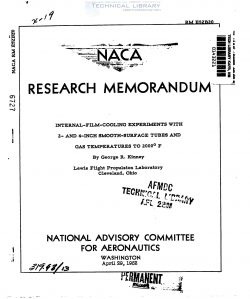naca-rm-e52b20
- Version
- 38 Downloads
- 1,012.50 KB File Size
- 1 File Count
- May 25, 2017 Create Date
- May 25, 2017 Last Updated
National Advisory Committee for Aeronautics, Research Memorandum - Internal Film Cooling Experiments with 2 and 4 Inch Smooth Surface Tubes and Gas Temperatures to 2000°F

An investigation of liquid-film cooling was conducted in 2- and.
4—inch-diameter straight tubes having honed inner surfaces with air
flows at temperatures from 800° to 20000 F and diameter Reynolds numbers
from 220,000 to 1,100,000. The film coolant, water, was injected at a
single axial position on the tube at flow rates from 0.02 to 0.24: pound.
per ilecond per foot of tube circumference (0.8 to 12 percent of the air
flow.
Correlation was obtained for heat-transfer from the hot air to the
liquid-cooling film with the 2- and 4-inch-diameter smooth-surface tubes
and. was the same as was found in a previous investigation with a 4-inch—
diameter rough-surface tube. Heat-transfer coefficients were about
20 percent lower with the smooth-surface tubes than with the rough-
surface tube.
Effectiveness of the coolant was decreased by coolant-film distur-
bances in a 2-ineh-diameter tube, as was found in a previous investiga—
tion in a 4-inch-diameter tube. The approximate coolant flow above
which reduced cooling effectiveness resulted was predicted by a method
developed in a previous investigation.
All film-cooling data obtained with smooth-surface tubes were gen-
eralized by means of heat-transfer correlation and data obtained over
a range of coolant flows. This generalization of data facilitates the
estimation of the flow of coolant required to film cool a tube for a
desired length, over a wide range of conditions, when the temperature
and flow of the hot gas are known.
Combustion chambers and ducts which are subjected to extremely high
heat transfer from flowing hot gases may be difficult to cool by circu-
lation of a fluid over the outer walls. Internal-film cooling, wherein
a coolant film is formed between the hot gases and the duct wall to
maintain the wall at low temperature, may be used in such cases. The
effectiveness of liquid-film cooling in reducing heat transfer to rocket
nozzles and combustion chambers is described in references 1 and 2.
Investigations concerned with establishing liquid—cooling films for
rocket engines are described in references 5 and 4; and reference 4.
summarizes work on rocket heat transfer, sweat cooling, and. film
cooling.
| File | Action |
|---|---|
| naca-rm-e52b20 Internal Film Cooling Experiments with 2 and 4 Inch Smooth Surface Tubes and Gas Temperatures to 2000°F.pdf | Download |
Comment On This Post